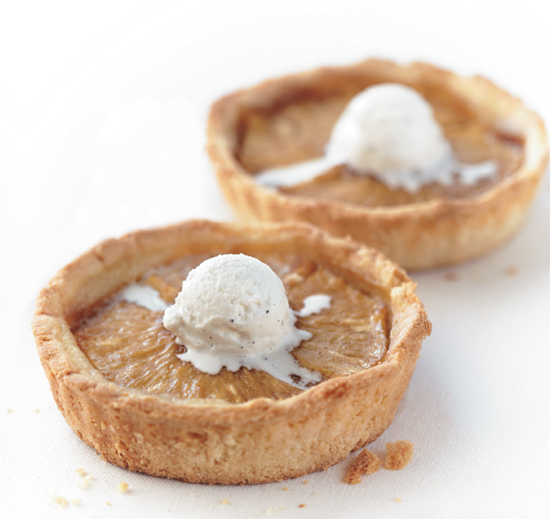
DESSERTS
I love desserts—rich buttery cakes piled high with frosting, fruit pies with flaky crusts, smooth creamy custards, gooey puddings, and chocolate in any incarnation. However, Asian desserts generally follow a different philosophy from the European confections that excite my sweet tooth. Undressed fresh fruits are always a welcome, delicious end to an Asian meal, highlighting nature’s simplicity. Along the same lines, fruits and even vegetables (namely yams, mung beans, or corn) are sweetened with a sugary syrup and lightly flavored with ginger or citrus peel to make a unique dessert soup. Steamed cakes thickened with tapioca starch or glutinous rice flour are more the standard than oven-baked, egg-leavened cakes. Stovetop puddings are also a common favorite with tapioca pearls and rice heading the top of the list.
Fortunately, with Filipino cuisine, you don’t have to decide between the European and Asian dessert philosophy since they are both incorporated into everyday sweets. Naturally, geography has determined popular ingredients used for desserts. Coconut plays an essential role as in the Buko Pandan Sago, a nostalgic yet satisfying dessert of tapioca pudding, lightly scented with fragrant pandan leaves and coconut milk for a classic flavor combination. Caramelized mangoes crown the tapioca for a tropical flourish. Cassava’s starchy root is also featured here, grated and used as an alternative to wheat flour in the Pineapple and Cassava Tarts and the Ambrosia Shortcake with Cassava Biscuit, a Filipino interpretation of an American classic.
The Spaniards are responsible for integrating buttery cakes and eggy custards into Filipino cuisine. Almond Leche Flan, a fiesta staple, is made even richer than the original Spanish version by using egg yolks instead of whole eggs. The addition of condensed and evaporated milks gives our flan a distinctive “Filipinoness” that sets it apart from Spanish or Mexican flan. Natilla is a baked custard very similar to French crème brûlée, although it typically does not have a burnt sugar crust. I’ve lightly scented my natilla with the flavor of Earl Gray tea, a delicious pairing with custard.
Cakes in this chapter are abundant. The Chocolate Brazo de Mercedes is a lighter version of the American jelly roll. Instead of a traditional ube (sweetened purple yam) filling, I’ve dusted the meringue cake with cocoa powder and wrapped it around chocolate cream. Because there is nothing more perfect than a light dessert to enjoy at summer cookouts, I’ve also included multiple Brazo variations, using lemon, mocha, and pumpkin. Sans Rival, a showstopping rectangular torte of vanilla cream layered in between cashew meringue cake cloaked in chocolate ganache, is an extravagant treat that your family and friends won’t soon forget.
I’ve strayed from tradition here, by highlighting desserts suited more for after-dinner enjoyment. Small finger sweets such as powdered rice candies (polovones), almond or peanut candies (pastillas), and rice cakes (cuchinta or bibinka), although common confections, are often taken as snacks during merienda but are not necessarily appropriate dessert fare the way Westerners think of dessert. Luckily, there are many traditional Filipino desserts that make an easy transition to the dinner table. Turon, fried fruit egg rolls, are filled with bananas, chocolate, and macapuno (preserved coconut). These treats are as quick to prepare as they are to cook. They’re also an invaluable asset in my freezer for the unexpected guest or a midnight craving. Halo-Halo, probably the most native of our traditional desserts, is a summertime pleasure that goes beyond ice cream, sundaes, or milk shakes. Meaning “mix-mix,” halo-halo is a combination of fresh and preserved fruits, shaved ice, ice cream, and evaporated milk that is best eaten with both a spoon and straw.
PINEAPPLE AND CASSAVA TARTS
In addition to being an excellent cook, my mother is an accomplished baker. Her cassava cake is a family institution guaranteed to convert dessert skeptics into devotees. My rendition of cassava cake admits to being a restaurant-friendly replica with unpretentious adornments worthy of the homey original. In tart form, these minicakes sandwich cassava batter in between a light puff pastry crust and a juicy caramelized pineapple. Serve the tarts lightly warmed with a scoop of vanilla ice cream for added pleasure.
Makes 6 tarts
2 lbs (900 g) store-bought puff pastry dough, thawed
Cassava Cake
1 (8-oz/225-g) package grated cassava
2½ cups (625 ml) milk
1 (14-oz) can sweetened condensed milk
¼ cup (50 g) granulated sugar
3 large eggs
1½ sticks (170 g) butter, melted
Pineapple Topping
1 ripe pineapple, peeled, cored, and sliced into ½-in (6-mm) thick rings
½ cup (100 g) brown sugar
3 tablespoons water
½ teaspoon vanilla extract
Preheat the oven to 350°F (175°C). Lightly spray 6 (4-inch/10-cm) mini-tart pans, with removable bottoms, with oil or pan spray. Unfold the thawed puff pastry dough and cut out six circles, roughly 6 inches (15 cm) in diameter. Press the dough circles into the tart pans and refrigerate until ready to fill.
Combine the cassava, milk, condensed milk, sugar, eggs, and melted butter in a mixing bowl and whisk together. Place the tart pans on a baking sheet. Ladle the tart pans with the cassava batter, leaving ½-inch border from the top rim of the tart. Bake for 25 minutes until the batter begins to set.
Remove the tarts from the oven and lay a pineapple ring in the center of each tart. Mix together the brown sugar, water, and vanilla in a small bowl. Brush the sugar mixture on top of each pineapple and return the tarts to the oven. Bake for another 20 to 30 minutes until the batter is set and the pineapple is golden brown.
Once you’ve removed the tarts from the oven, let them cool for 10 minutes before unmolding. Serve with a small scoop of vanilla ice cream.

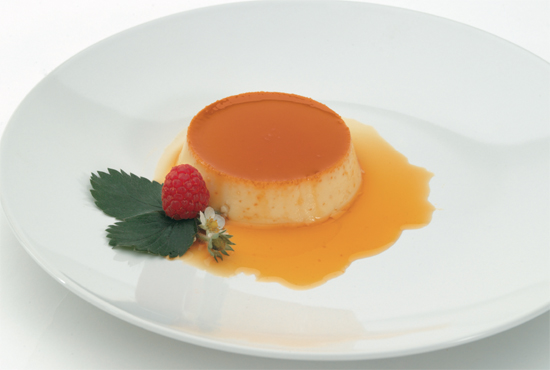
ALMOND LECHE FLAN
There’s a quiet elegance to a well-made flan that belies the recipe’s simplicity. Perhaps it’s the dark shiny caramel melted into a sweet sauce, or the creamy custard with just the right balance of eggs and milk that makes the flan rich yet light, or the perfectly smooth texture without an air bubble in sight to mar the silkiness. Leche flan is a fiesta favorite often served in a large mold well suited for the buffet table. For a no-fuss, make-ahead dessert that is sure to impress, I often serve flan individually, baked in ovenproof coffee cups or ramekins.
Makes six 4-oz (125 ml) flans
Caramel
1 cup (200 g) sugar
Flan
1 (12-oz/360-ml) can evaporated milk
½ cup sweetened condensed milk, approximately half of a 14-oz/420-g can
6 large egg yolks
½ cup (125 ml) half-and-half
1 teaspoon almond extract
Make the caramel: Place the sugar in a very clean, heavy-bottomed saucepan and cook over medium heat for 8 to 12 minutes. As the sugar melts, use a very clean pastry brush dipped in water to brush down any sugar that bubbles up the inside of the pan. Pour the caramel into six 4-ounce (125-ml) ovenproof ramekins, making sure that it covers the entire bottom. Set the molds aside and let the caramel cool completely for 15 to 20 minutes. Soak the saucepan and wooden spoon in water to dissolve the caramel for easy cleaning.
Make the flan: Combine the evaporated milk, condensed milk, egg yolks, half-and-half, and almond extract into a large bowl. Stir with a whisk, being careful not to incorporate air into the mixture. Place a fine-mesh strainer over another bowl and pour the flan through. Pour the flan into ramekins over the cooled caramel.
Cook the flan: Preheat the oven to 350°F (175°C). Place the ramekins in a large, high-sided baking dish. Pour hot tap water into the larger dish so that it reaches halfway up the sides of the ramekins. Bake the flan in the water bath loosely covered with aluminum foil for 40 to 50 minutes. The flan is ready when the surface is set but has a slight jiggle when you tap the ramekins. Remove the water bath from the oven. Remove the ramekins from the water and cool to room temperature. Cover with plastic wrap and refrigerate overnight. Flan is best served after 24 hours when the caramel has had ample time to dissolve and the custard is completely cool and set.
Unmold the flan: Run a knife around the inside of the ramekins, separating the flan from the mold. Place an individual serving plate over the flan and invert onto the plate. Pour any dissolved caramel onto the flan and serve.
Variation: Fiesta Style Flan. To make 1 large flan, follow the caramel recipe as directed above and pour into a 10-inch-round or 9-inch (22-cm)-square baking dish. Double the flan recipe and bake in a 325°F (160°C) preheated oven in a water bath loosely covered with aluminum foil for 60 to 70 minutes until the flan is set in the center. Cool, refrigerate, and unmold the flan as directed.
FILIPINO FRUIT SUNDAE HALO-HALO
If there is such a thing as a national dessert of the Philippines, halo-halo proudly holds the title. Meaning “mixmix,” this multilayered dessert is a sundae-milk shake-slushy hybrid that’s sure to quell summer’s simmering heat. Halo-halo features an assortment of tropical fruits and sweetmeats chilled with shaved ice, ice cream, and evaporated milk. As the name indicates, halo-halo ingredients are a mélange of flavors and textures ranging from fresh bananas to sweet corn to preserved delicacies such as coconut gel (nata de coco), purple yam paste (ube), and sweetened kidney beans. Master halo-halo makers even go so far as to include flan custard, agar-agar, puffed rice (pinipig), or garbanzo beans. Perhaps it’s my Western upbringing, but I’ve always preferred more fruit in my halohalo than anything else, which is why this recipe is subjectively fruit-sided. The signature flavor of jackfruit is fundamental as are the chewy strands of coconut sport (a variety of the coconut palm plant), which you’ll find jarred under the name macapuno.
One of the keys to an authentic halo-halo is shaved ice. Though crushing ice in a blender may seem like a viable alternative, a blender can’t process ice into the fine flakes that make halo-halo unique. Since shaved ice drinks and desserts are popular throughout Asia, you’ll be sure to find either an electric or manual ice shaver at an Asian grocer. They are also available at large chain stores that sell kitchen goods.
Serves 4
3 cups (300 g) shaved ice
1 cup (170 g) diced mango
1 cup (175 g) diced pineapple
1 cup (150 g) diced jackfruit, with juice
1 cup (225 g) macapuno strings
1 cup (200 g) preserved purple yam (ube)
1 (12-oz/340-g) can evaporated milk
Vanilla ice cream, garnish
In 4 tall sundae or milk shake glasses, place ¾ cup (75 g) shaved ice. On top of that, add ¼ cup (approximately 50 g) each of mango, pineapple, jack-fruit, macapuno strings, and purple yam. Pour ½ cup (125 ml) evaporated milk and some of the jackfruit juice into each glass. Top the halo-halo with a scoop of vanilla ice cream.
Serve with long ice cream spoons to mix the layers together.
Variation: If you don’t feel like buying each ingredient separately, prepared halo-halo fruit mixes are available at the Asian grocer. These convenient, pre-made mixes come in glass jars and, depending on the brand, include a combination of halo-halo staples such as sweetened beans, coconut sport, purple yam, coconut gel, and palm nuts. Place a few spoonfuls of the mix in a glass, then top with shaved ice, evaporated milk, and vanilla ice cream for a nearly instant halo-halo. I find the mixes are a great base to which you can add your favorite fruits such as jackfruit, litchi, banana, mango, papaya, or guava.

TEA CUSTARD EARL GRAY NATILLAS
Overshadowed by the national popularity of leche flan, natilla may be the obscure Filipino custard, though no lesser in any other comparison. Light and creamy natillas are often called the soft custard, comparable in texture to crème brûlée, which makes it difficult to serve on a fiesta buffet table. Instead, natillas are more suited for individual servings, easily baked in ramekins and dressed with fresh fruit for effortless panache. Earl Gray tea and cream may seem an unlikely pairing for dessert, but the delicate perfume of bergamot oil leaves a sunny citrus essence that charms and calms the palate.
Makes four 4-ounce/125-ml ramekins
1½ cups (375 ml) heavy whipping cream
3 tablespoons granulated sugar
1 Earl Gray tea bag or 1 teaspoon loose tea
3 large egg yolks
½ cup (75 g) ripe strawberries, for garnish (optional)
½ cup (30 g) whipped cream, for garnish (optional)
Preheat the oven to 350°F (175°C). Combine the cream, sugar, and tea in a heavy-bottomed saucepan. Simmer for 5 minutes. Place the egg yolks in a heatproof bowl. While whisking the egg yolks, slowly pour the hot cream into the yolks until all of the cream is incorporated. Strain the mixture through a fine sieve.
Arrange 4 (4-ounce/125-ml) ramekins in a deep baking dish. Ladle the cream mixture into the ramekins and fill the baking dish with water so that it reaches halfway up the sides of the ramekins. Cover the baking dish loosely with aluminum foil and bake for 45 minutes until the centers of the natillas are set but jiggle slightly when tapped.
Remove the baking dish from the oven. Use tongs to remove the ramekins from the water and cool to room temperature. Cover the ramekins with plastic wrap and refrigerate for at least 2 hours before serving.
Garnish with fresh, ripe seasonal strawberries and whipped cream. In the style of crème brûlée, you can caramelize a sugar crust on top of the natillas before serving. Simply sprinkle granulated sugar evenly over the top of the natillas. Use a kitchen blowtorch to caramelize the sugar. If you don’t have a blowtorch, place the ramekins underneath the broiler, as close to the flame as possible to caramelize the sugar.
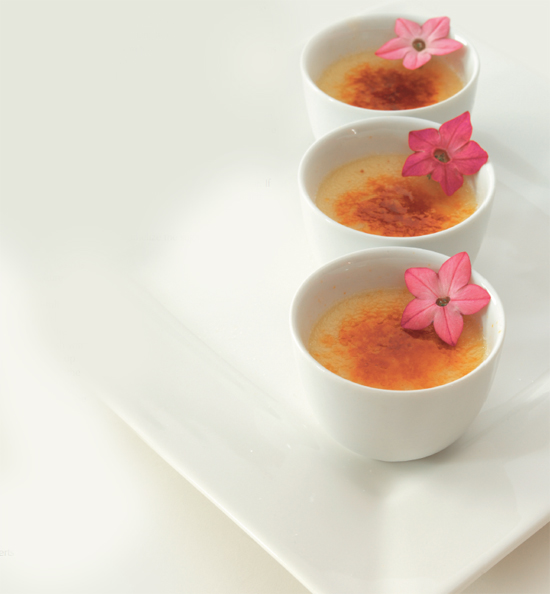
MERINGUE ROLL WITH CHOCOLATE CREAM CHOCOLATE BRAZO DE MERCEDES
This featherlight cake reminds me of a classic French dessert that’s rarely seen on restaurant menus nowadays but still holds timeless quality and absolute satisfaction, oeufs à la niege, or poached meringue blanketed with a vanilla sauce of crème Anglaise. A traditional brazo de mercedes boasts the same alliance of textures and flavors but in the form of a pillowy rolled meringue cake filled with creamy egg custard. Because the cake is very delicate, it requires an airy filling that won’t weigh it down. This versatile filling is a simple treasure thickened with egg yolks instead of flour or cornstarch. It starts off pudding-rich but is lightened with whipped cream to make an elegant mousse that can be served alone or spread liberally as a filling or frosting for your cake. To the classic vanilla-flavored brazo, I’ve added cocoa powder and melted, semisweet chocolate morsels for added decadence.
Serves 8
Meringue Cake
8 large egg whites
¾ cup (150 ml) granulated sugar
½ teaspoon cream of tartar
Chocolate Filling
1 (14-oz/420-g) can condensed milk
¼ cup (50 g) semisweet chocolate morsels
1 teaspoon vanilla extract
8 large egg yolks, beaten
1 cup (250 ml) cold heavy whipping cream
2¼ teaspoons unflavored gelatin or 1 gelatin packet
2 tablespoons cocoa powder, for dusting
2 tablespoons confectioners’ sugar, for dusting
Make the cake: Preheat the oven to 350°F (175°C). Line a 10 by 15 by 1-inch (25½ by 38 by 2½-cm) jellyroll pan with parchment paper. Place the egg whites in a large mixing bowl. Beat the egg whites with an electric mixer on low speed until frothy. Add the sugar in thirds, beating the whites on high speed to incorporate the sugar.
Once all of the sugar is added, beat the whites to stiff peaks. Pour the batter into the prepared jellyroll pan and evenly smooth the top. Bake for 25 to 30 minutes until the top of the cake has puffed above the rim of the pan and a toothpick inserted into the cake comes out clean. While the cake is baking, prepare the filling.
Make the filling: Combine the condensed milk, chocolate morsels, and vanilla in a heavy-bottom saucepan. Cook the mixture over low-medium heat until the chocolate is completely melted. Whisk the mixture and slowly drizzle the yolks into the pan. Cook the filling slowly over low heat for 5 to 7 minutes, whisking continuously, until a thicklike pudding. Place plastic wrap directly on the surface of the filling (this will prevent a film from forming) and cool to room temperature.
Place the whipped cream in a bowl and whisk to stiff peaks with an electric mixer. Add the gelatin and beat for another 10 seconds to combine. Fold the whipped cream into the cooled chocolate filling and chill in the refrigerator until you are ready to assemble the cake.
Assemble the cake: Remove the cake from the oven and cool for 5 minutes before handling. Combine the cocoa powder and confectioners’ sugar in a bowl and stir until well blended. Generously sift the cocoa-sugar mixture evenly over the top of the cake. This will prevent your cake from sticking when unmolded. Invert the cake onto a kitchen towel and peel off the parchment lining, being careful not to tear the meringue. Spread the cooled filling evenly on the bottom of the cake. Starting with a long side, gently roll up the cake and lay the cake seam side down. Chill the cake for 1 hour. Slice into rounds and serve.
Variation: Classic Brazo de Mercedes. This simple meringue cake is paired with a homey vanilla cream filling. It is the basic recipe upon which dozens of variations and flavors of brazo de mercedes are built. Simply omit the cocoa powder and the chocolate morsels from the chocolate recipe. When inverting the cake, use confectioners’ sugar instead of cocoa powder.
CASHEW TORTE WITH VANILLA MOUSSE SANS RIVAL
Meaning “without rival,” this torte succeeds in earning its name. Three layers of cashew meringue cake are mortared with a light cream that is used as both a filling and frosting. Toasted cashews traditionally decorate the face of the cake, although I’ve included in this recipe my preference for a chocolate ganache cloak. Admittedly, there are a few steps and components required in assembling a sans rival, which might cause you to limit it to special occasions. But the praise you’ll receive in addition to future requests for the cake will be worth the effort and perhaps make it a regular indulgence throughout the year.
Serves 6
Filling
¼ cup (50 ml) cold heavy whipping cream
3 tablespoons confectioners’ sugar
½ teaspoon vanilla extract
1 packet (2 teaspoons/10 g) unflavored gelatin
¾ cup (175 g) sour cream
Cake
2 cups (275 g) unsalted roasted cashews
1 cup (200 g) granulated sugar
3 tablespoons cornstarch
10 large egg whites
½ cup (50 g) confectioners’ sugar, for dusting
Make the filling: Combine the whipping cream, sugar, and vanilla in a mixing bowl. Sprinkle the gelatin over the cream and put the bowl in the refrigerator for 5 minutes; this will keep the cream cold while the gelatin softens. Remove the bowl from the refrigerator and beat the cream with an electric mixer on medium-high speed for 3 minutes until it holds stiff peaks. Add the sour cream and beat another minute to combine. Chill the mixture in the refrigerator until ready to use.
Make the cake: Preheat the oven to 350°F (175°C). Line a 10 by 15-inch (25 by 38-cm) jelly roll pan with parchment paper. Combine the cashews, sugar, and cornstarch in a food processor. Process for 30 seconds until the nuts resemble fine pebbles. Be careful not to over-process nuts into a paste. Set the ground nuts aside.
Place the egg whites in a large mixing bowl and beat with an electric mixer on low speed until foamy. Gradually add the sugar and increase the speed to high. Beat on high until the egg whites are thick and form stiff peaks. Gently fold the cashew mixture into the egg whites using a rubber spatula. Pour the batter into the prepared jelly roll pan and spread evenly. Bake until golden brown and a toothpick inserted into the center of the cake comes out clean, about 20 minutes. When completely cooled, slide the cake off the jelly roll pan, still attached to the parchment paper.
Assemble the cake: Lay the cake horizontally on your workspace and cut it across its length into thirds, making three equal rectangular pieces. Place one cake layer on a rectangular piece of cardboard cut to fit the cake. Spread one-third of the sour cream filling on the cake. Place the second cake layer on top and spread with more cream. Set the final layer on top. Smooth a thin layer of cream all around the top and sides of the cake and chill for 30 minutes.
Make the chocolate ganache: To make the ganache, combine 8 ounces of semisweet chocolate morsels, 1 tablespoon butter, and ½ cup heavy whipping cream in a microwaveable bowl. Melt on medium-high heat for 2 minutes. Stir the chocolate mixture and cook for another minute until completely melted and smooth. Cool the chocolate for 5 minutes so that it is slightly warm and not hot when poured over the torte.
Position the cake on a cooling rack fitted on a sheet pan or jelly roll pan. Pour the melted chocolate ganache liberally over the top of the torte, smoothing the chocolate over the top and sides of the cake with a flat metal spatula until completely covered. Any drips of chocolate should fall onto the sheet pan. Return the cake to the refrigerator and chill for 30 minutes before serving.
COCONUT-PANDAN TAPIOCA BUKO PANDAN SAGO
Tapioca may seem like an old-fashioned dessert from a bygone era in American history. But like many dishes that fill us with nostalgic comfort, these tender pearls are making a comeback on restaurant menus and in home kitchens alike. Tapioca is made from the gelatinized starch of the cassava plant, a very starchy root native to South America but popularly grown all over the world. This pudding features the beloved buko pandan flavor combination that Filipinos are so fond of. Coconut milk steeped with fragrant pandan leaves give this wholesome favorite a tropical accent, and slices of caramelized mango on top add a juicy jolt of sweetness. Be sure to use quick-cooking tapioca for speed and ease. Whole or pearl tapioca can be substituted but you’ll have to soak it for 10 to 15 minutes (that’s for tiny pearls, 30 minutes for large pearls) in warm water to soften it completely before cooking.
Serves 6
1 (13½-oz/400-g) can coconut milk
½ cups (375 ml) low-fat milk
½ cup (100 g) sugar
1 pandan leaf, approximately 8-in (15-cm) long
1 teaspoon vanilla extract
Dash of salt
½ cup (90 g) quick-cooking tapioca
2 large egg yolks
1 ripe mango (substitute peaches, pineapple, or bananas)
1 tablespoon sugar
½ cup (30 g) whipped cream, for garnish
Make the tapioca: Combine the coconut milk, milk, sugar, pandan leaf, vanilla, and salt in a medium saucepan. Simmer over low heat for 15 minutes to infuse the milk with the pandan. Remove and discard the leaf.
Add the tapioca to the pan and simmer on the lowest heat setting for 5 minutes, stirring frequently to prevent the tapioca from sticking to the bottom of the pan. Add the egg yolks one by one, stirring after each addition and cook for another 5 minutes until the pudding is thick and the tapioca is tender.
Cool the tapioca to room temperature, then chill in the refrigerator for 1 hour before serving.
Caramelize the mango: Position your oven rack directly underneath the broiler. Peel the mango and cut into ½-inch (13-mm) slices. Place the fruit on a greased baking sheet and sprinkle each slice with sugar. Place the mango under a preheated broiler for 1 to 2 minutes until the sugar turns golden brown. Remove from the oven and cool the mango for 5 minutes. Spoon on top of the chilled tapioca with a dollop of whipped cream.
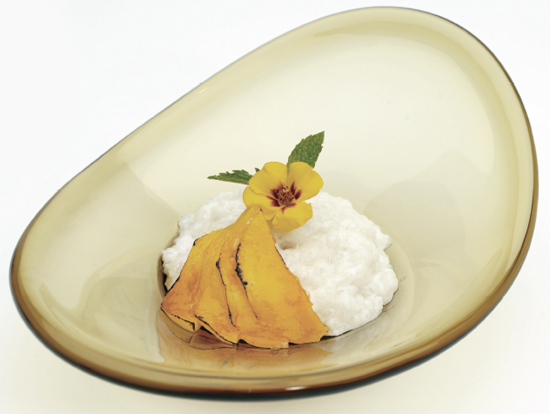

AMBROSIA SHORTCAKE WITH CASSAVA BISCUIT
The classic strawberry shortcake gets a tropical face-lift with this recipe. Grated cassava gives the sweet biscuit a little weight and texture, almost like a scone. Serve the biscuit alone as the perfect teatime snack adorned with little more than butter or whipped cream. Or pair it with a refreshing fruit salad made with summer’s bounty of fresh mangoes and strawberries for a lovely finale to dinner, whether it be a fancy affair or a backyard barbecue.
Serves 6
Cassava Biscuit: makes twelve 2½-in (6½-cm) biscuits
1½ cups (200 g) all-purpose flour
1 cup (225 g) frozen grated cassava, thawed and drained
1 tablespoon sugar
1 tablespoon baking powder
¼ teaspoon salt
½ cup (125 g) cold butter, cut into thick slices
⅔ cup (150 ml) coconut milk
Fruit Salad
1 mango, peeled, deseeded, and cut into ½-in (6-mm) cubes
1 cup (125 g) sliced strawberries
1 (4-oz/125-g) can mandarin oranges, drained
1 cup (175 g) fresh pineapple, cut into ½-in (6-mm) cubes
¼ cup (50 g) sweetened shredded coconut
1 cup (250 ml) whipped cream
Make the biscuit: Preheat the oven to 450°F (230°C). Combine the flour, well-drained cassava, sugar, baking powder, and salt in a food processor. Sprinkle cold butter slices over the flour and pulse the food processor until the mixture resembles coarse crumbs. Pour in the coconut milk and pulse until the dough barely just comes together.
Turn the mixture onto a well-floured surface and flatten to a 1-inch (2½-cm) thickness. Use 2½-inch (6½-cm)-round biscuit cutters to cut 12 biscuits. Place the biscuits on a baking sheet. Lightly brush the tops of the biscuits with melted butter and sprinkle with sugar. Bake for 12 to 15 minutes until golden brown. Cool on a wire rack for 5 minutes. Use a serrated knife to split the biscuits in half horizontally.
Make the salad and assemble the shortcakes: Combine the mango, strawberries, mandarin oranges, pineapple, and coconut in a large bowl. Toss together. Place the bottom of the biscuit on a plate. Spoon the fruit salad onto the biscuit. Top with whipped cream (or vanilla ice cream) and lay the top of the biscuit over the cream. Serve immediately with extra whipped cream.
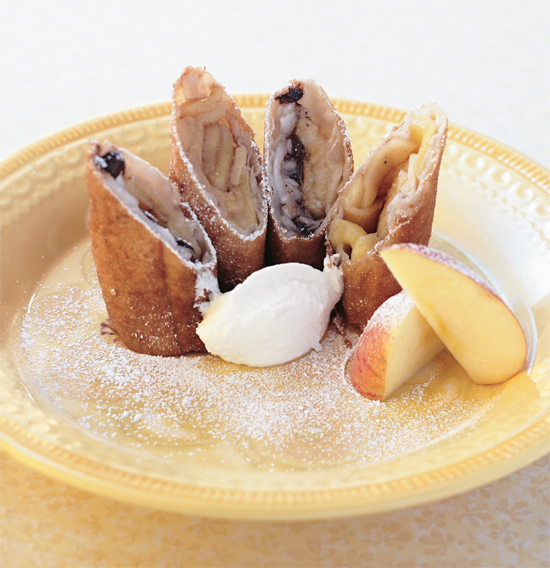
BANANA, CHOCOLATE, AND COCONUT EGG ROLLS TURON
These egg rolls were not so much dessert in my house as they were merienda fare, a light midmorning or midafternoon snack served with coffee or hot chocolate. The banana-chocolate-coconut combination is a personal favorite of mine, although not one that I grew up with. (Macapuno strings, a variety of the coconut palm plant, also called coconut sport, adds a signature Filipino flavor and pleasingly chewy texture.) The classic turon of my youth was filled with slices of ripe plantain and juicy jackfruit for a warm crispy snack that was just sweet enough to be considered a treat. These rolls are literally a cinch to make and a treasure to have stashed in the freezer as an impressive offering for the unexpected guest or merely as an indulgence to satisfy your own sweet tooth.
Makes 12 turon
1 package (25 sheets) lumpia wrappers or super-thin spring roll wrappers, defrosted
3 bananas, peeled
1 cup (200 g) semisweet chocolate morsels
1 (12-oz/340-g) jar macapuno strings
1 large egg, beaten
2 to 3 cups (500 to 750 ml) oil, for frying
Prepare the wrappers and bananas:
Gently pull the wrappers apart, being careful not to tear them. Once separated, cover the wrappers with plastic wrap or a towel to keep them from drying out until you are ready to use them.
Slice the bananas in half lengthwise, then again across the center so that there are 4 halves per banana, 12 pieces in total.
Assemble the egg rolls: Position a wrapper on your workspace so that the square faces you. Center a banana, cut side down, ½ inch (13 mm) above the bottom edge of the wrapper. Spoon about a tablespoon of macapuno strings on the banana, then sprinkle a few chocolate morsels on top of the macapuno. Use your fingers to lift the bottom edge over the filling. Roll the banana once tightly then fold in both sides toward the center. Brush the top edge with the egg. Roll up the egg roll and press to seal. Take another wrapper, this time with a corner facing you. Wrap your egg roll a second time using the same method. This will ensure that the filling will not leak out into the oil and burn.
Place the filled egg rolls on a platter, seal-side down, covered with a towel to keep from drying out. Repeat with the remaining bananas.
Cook the egg rolls: Heat the oil in a frying pan to 350°F (175°C). Cook the egg rolls 3 to 5 minutes, turning them so that they brown evenly on all sides. Remove from the oil and drain on paper towels. Serve immediately.
Variation: Cinnamon-spiced apples and canned jackfruit make an excellent combination in turon. In a large skillet combine 2½ pounds (1¼ kg) apples, peeled, cored, and sliced; 2 tablespoons butter; ½ cup (115 g) brown sugar, 1 teaspoon ground cinnamon, and ¼ teaspoon ground ginger. Cook and stir over medium heat until the apples are tender, about 15 minutes. Cool the apple mixture. Drain and slice the jackfruit into thin strips.